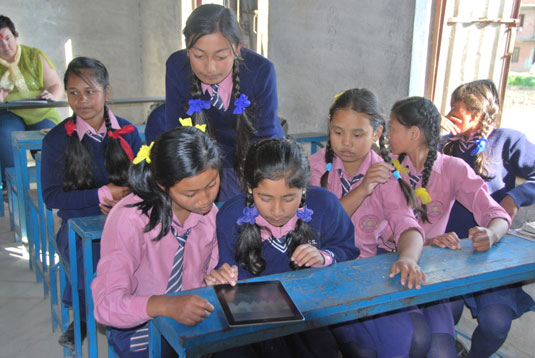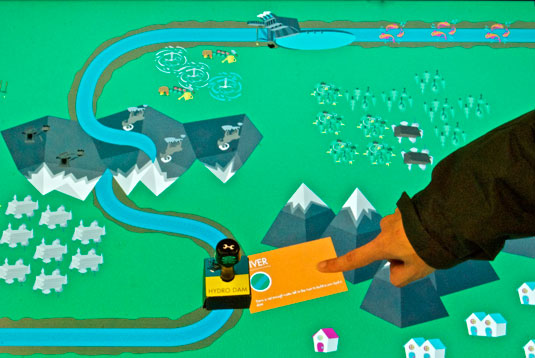

Students in Nepal at a workshop during the Advances in Computer Entertainment (ACE 2012). PHOTO: Alissa Antle.
(VANCOUVER) For many children living in Nepal – a country troubled by poverty, civil war and social unrest – life is scarred by traumatic events. Those fortunate enough to escape the violence, neglect and abuse nonetheless face immense challenges in healing and recovering, as well as in receiving basic schooling.
Having seen these challenges firsthand, Dr. Alissa Antle, an Associate Professor at Simon Fraser University, is leading research into how edutainment-based interactive technologies can improve the lives of urban Nepalese children, their families and their communities.
An expert in child-computer interaction and co-leader of GRAND’s DIGIKIDZ project, Antle’s team organized a creative design workshop for urban Nepalese children at ACM’s 9th International Conference on Advances in Computer Entertainment (ACE 2012). Along with other workshop organizers her team was awarded the ACE Diamond Award.
Now she is working with the Nepal House Society, an NGO created to support and educate children from orphanages and slums, to test a biofeedback Android tablet game. The goal is to improve children’s ability to self regulate so they can more effectively attend and focus during their education at the Nepal House School.
Simple tablet game helps children learn self-regulation to better focus and learn
During an informal discussion with Nepal House counsellor Leslie Chesick, Antle learned how trauma therapy methods such as meditation, breathing and yoga were being used at the school to help children develop “affect regulation,” focus, and attention. Affect regulation is the ability to purposefully increase, or maintain, positive states of wellbeing, or positive affective states, and to decrease or regulate stress and negative affect states such as anxiety and fear.
The staff were having a difficult time, however, teaching the essentially internal techniques, as well as telling whether a child was practicing them effectively.
“The children weren’t really clear about what they’re supposed to be doing and the teachers weren’t clear on whether the children were getting it,” said Antle.
She realized that a simple and inexpensive biofeedback game on a computer tablet might offer a solution.
Using biometric sensors, the game would monitor physiological states, including heart rate variability, which can indicate a child’s affect or arousal state. Inputted into a multimedia activity like a game, this information can provide visual and game-based biofeedback that can be represented in a simple and culturally appropriate form. (Antle gives the example of animated Buddhist prayer flags (commonly seen in Nepal) that might speed up or slow down according to high or low arousal state.) She hypothesizes that this feedback information may help children learn to consciously monitor and adjust their physiological state.
“By teaching kids to consciously regulate physiological and affective states, they may be better able to do that in a classroom situation, and may be better able to focus and pay attention to what they’re trying to learn,” said Antle.
The enjoyment of the game would further motivate young players to practice meditation techniques – since these techniques require repetition. Counsellors and teachers would also receive feedback about each child’s progress through the application.
"Most of the young girls that attend our school, and all of the children that attend counselling at Nepal House have experienced trauma which leads to a variety of reactive and problematic behaviours," said Chesick. "It is our hope that the tablet games and accompanying neuro-feedback will engage the children in activity that will help them learn, in a fun and culturally relevant and engaging way, how to regulate their heart rate variability. There is a lot of research on the benefits of regulating heart rate variability leading to better impulse control, focus, and general ability to deal with stress."
Antle’s game idea was based on an immersive environment she developed in 2008 through a SSHRC-funded project. Intended for a group of local children who were experiencing difficulty self-regulating negative emotions arising in the classroom due to their learning disabilities, the game had young players use biofeedback to catch butterflies projected inside the walls of a tent.
“About five years ago there started to be evidence that biofeedback games might be useful for teaching meditation and for helping children better manage ADHD, anxiety and chronic pain. Unlike when I built the butterfly tent, [we] now have a solid research bank behind the project,” said Antle. “We pitched this [tablet game] idea to the [Nepal House Society] board and they were really excited about it.”
A prototype is currently being developed to supplement the therapeutic methods used at Nepal House School. Designed for the Android platform, the game is intended for wide adoption. Antle is currently looking for sponsors to help make it freely available to those who need it the most – in particular, underprivileged children in the third world.
If successful, the technology could help improve the education and literacy of thousands of children. Modified versions may also be used in the rehabilitation of traumatized child soldiers, and help reduce anxiety in pre-operative children or those learning to manage ADHD.
Antle is also planning to develop a similar game for a study with the Surrey school board to introduce this self-regulation tablet application to children from lower socio-economic backgrounds, and those struggling with FASD or ADHD.
Embodied interaction future of interface design
With the spread of camera vision based systems (e.g. Microsoft's Kinect platform) and interactive surfaces (e.g. tablets and smart phones), child-computer interaction has moved beyond the traditional desktop. No longer are users tied to a keyboard or to single interactions using a mouse. The future of computation, for Antle, lies in “Embodied Interaction,” with computers responding to touch and whole-body movement, as well as sound and vision. Her new design principles and prototypes incorporate these new modalities.

Youtopia is a collaborative interactive tabletop game for two that introduces elementary school aged children to issues surrounding sustainable development. PHOTO: Alissa Antle.
One example, funded in part by GRAND, is a collaborative tabletop game called Youtopia designed to introduce young children to sustainable development. In the game, players discover how to develop natural resources to build dams, farms and housing, and see the results of their activities on the environment, and in meeting population needs. The interactive game – a hybrid of tangible and multi-touch displays – is easy and straightforward to use. Using actual wooden stamps, players can physically stamp different land uses onto a large interactive tabletop map. Kids waste no time learning software or menus, leaving more time to learn, reflect and work together.
The game is designed for two players to work collaboratively – a unique design feature. One player develops the natural resources into usable resources, and the other uses those resources to build developments that meet human needs. This encourages discussion and shared decision-making as with real land use planning. The game also has neither winners nor losers. Instead, players work towards making a world both can live in, focusing on dialogue and reflection rather than winning the game.
“The game allows children to be stakeholders in a process of designing a world they want to live in,” said Antile. “This helps them understand their values and reflect on them.”
Antle’s team is working with private schools and school boards, as well as the Telus World of Science, and recently Microsoft and Sesame Street Workshop, to design and implement other new tools, while gathering valuable input from people who work with children on a daily basis. As with the Nepal House project, involving children in the design process has also been crucial to creating applications that address challenges and needs faced by children in their particular culture and social context.
“Working with children really helps me push the boundaries of computation, and to see how we can supplement and augment the way they think and play and learn,” said Antle. “Children are the future, and their whole world is becoming digital. Its really important to understand real benefits when designing interfaces for children so that products aren’t just mind candy.”
Industry need for informed child-centred design
Before returning to academia, Antle spent eight years developing digital media content and interfaces for children, including acting as the executive producer and creative director for CBC4Kids.ca, and the senior designer and development lead for the eLearning start-up Brainium Technologies. During that time, Antle noticed the lack of awareness of children’s needs and developmental abilities in the design of technology – a problem she considers industry wide.
“I saw with the startup a real need to make academic knowledge about child development accessible to designers of children’s media,” said Antle. “And that’s what drove me to go back and take an academic position.”
Antle’s research aims to break new ground in child-computer interaction with design guidelines specific to children and accessible to industry. The guidelines will help designers of children’s products understand how children can gain real benefits from the use of digital games and media. The goal is to harness the motivational power, and the amount of time and attention children are willing to give to interactive media to help them learn and develop. Antle is focusing on the next generation of interactive media that support a much wider range of gestures and body movements than traditional desktop systems.
“I’m really looking for the places where technology can help kids learn better or differently,” said Antle. “[It’s an] opportunity to augment the way they move in the world, the way they play and naturally interact in the world through computation and really improve their experiences.”
-30-
Contact:
Spencer Rose
Communications Officer
GRAND NCE